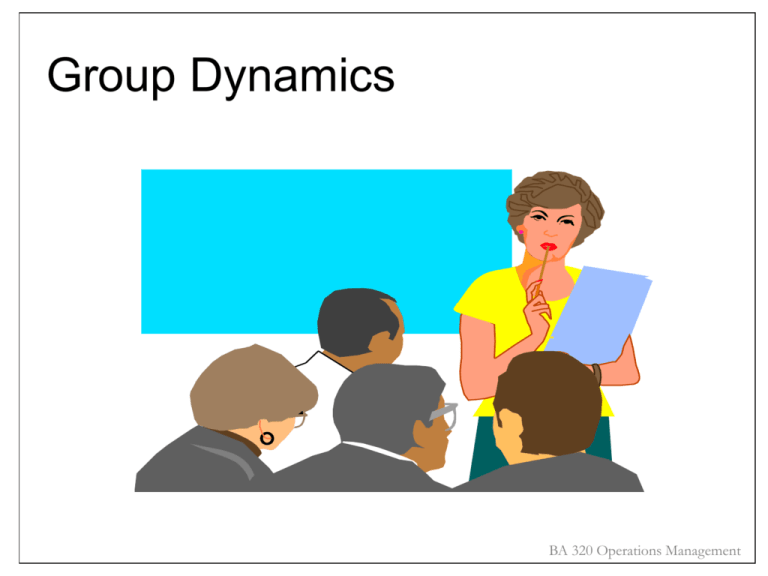group development theory
advertisement

Group Dynamics BA 320 Operations Management Overview • Define “groups” • Distinguish between formal and informal groups • Reasons people join groups • Four stages of group development • Specify group tasks and maintenance functions BA 320 Operations Management Formation of groups A group is more than two persons who interact with each other in such a manner that the behavior or performance of one is influenced by the behavior of the others. BA 320 Operations Management Two group types • Formal groups (task oriented) • Informal groups (social oriented) BA 320 Operations Management Reasons for group formation • • • • • • SECURITY SOCIAL ESTEEM PROXIMITY ATTRACTION ORDERED TO BA 320 Operations Management Four stages of group development • • • • Form stage Storm stage Norm stage Perform stage BA 320 Operations Management Form stage • First stage – behavior of group members can be described as : • DEPENDENT ON DIRECTION • MEMBERS ARE POLITE • INTRODUCTION AND SHARING OF INFORMATION • STEROTYPING INDIVIDUALS BASED ON FIRST IMPRESSIONS • CONVERSATIONS ARE ABOUT SAFE ACCEPTABLE TOPICS • AVOID DISCLOSURE, FEEDBACK, AND INTERPRETING NON-VERBALS BA 320 Operations Management Storm stage • Second stage – behavior of the group can be characterized as: • COUNTER-DEPENDENT: EACH GROUP MEMBER STRONGLY FEELS THE NEED TO TAKE CARE OF HIMSELF/HERSELF DURING THIS STAGE • BID FOR POWER • COMPETITIVE • RATIONALIZATION • CLOSE-MINDED • CONFLICT/HOSTILITY • CLIQUES ARE FORMED BA 320 Operations Management Storm stage - continued • UNEXPRESSED INDIVIDUAL NEEDS • CREATIVITY SUPPRESSED • TRY TO REACH RESOLUTION BY VOTE, COMPROMISE, OR ARBITRATION BA 320 Operations Management Norm stage • Third stage – behavior of the group can be characterized as: • INDEPENDENT AND CONSTRUCTIVE • REAL LISTENING TAKES PLACE • ATTEMPTS TO GAIN AND MAINTAIN CONTROL LESSEN • PROGRESS TOWARD OBJECTIVES • CREATIVITY BEGINS • ROLES IDENTIFIED • THE LEADER MAY BECOME SOMEWHAT LESS IDENTIFIABLE OR NECESSARY TO THE GROUP BA 320 Operations Management Perform stage • Fourth stage – behavior of the group can be characterized as: • INDEPENDENT • HIGH GROUP MORALE AND ESPRIT • INTENSE GROUP LOYALTY • INDIVIDUAL CREATIVITY IS ENCOURAGED • DISAGREEMENT IS OK • NO CLIQUES • GROUP ADOPTS AN IDENTIFICATION SYMBOL BA 320 Operations Management Adjourn stage • Fifth stage – behavior of the group can be characterized as: • LESS TASK ABILITY • REGRESSION TO LESS PRODUCTIVE BEHAVIOR • SEPARATION, GRIEVING BEHAVIORS • RE-DEFINITION • TERMINATION OR MINI-DEATH BA 320 Operations Management Relationship of team maturity and performance PERFORMANCE Possible Failure Possible Failure FORM STORM Immature Inefficient Ineffective Possible Failure NORM PERFORM ADJOURN Mature Efficient Effective BA 320 Operations Management Stages of team development and associated management challenges FORMING (Orientation) STORMING (Internal problem solving) NORMING (Growth and productivity) PERFORMING (Evaluation and control) 1. Establish structure, rules, communication networks 2. Clarify relations and interdependencies among members 3. Identify leader roles, clarify responsibility and authority 4. Develop plans for goals accomplishment. 1. Identify and resolve interpersonal conflict. 2. Further clarify rules, goals, and structural relationships 3. Develop participate climate among group members 1. Direct group activity toward goal accomplishment. 2. Develop data-flow & feedback systems for task performance. 3. Promote more cohesion among group members 1. Leader role emphasis on facilitation, feedback, and evaluation. 2. Renewal, revision, and strengthening of roles and group interdependencies. 3. Show of strong motivation toward goal accomplishment BA 320 Operations Management Summary • IDENTIFY THE WORKING DEFINITION OF A GROUP • IDENTIFY FORMAL AND INFORMAL GROUPS • IDENTIFY THE REASONS PEOPLE JOIN GROUPS • DESCRIBE THE FOUR STAGES OF GROUP DEVELOPMENT BA 320 Operations Management




